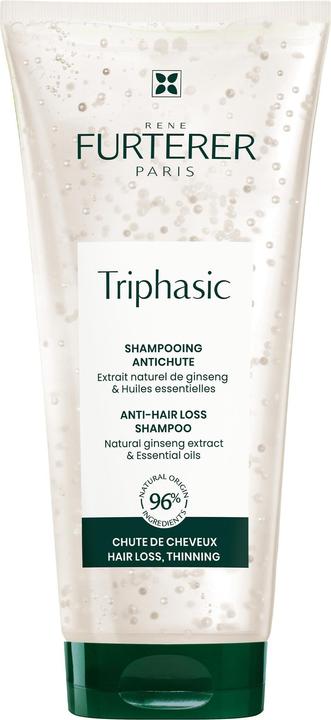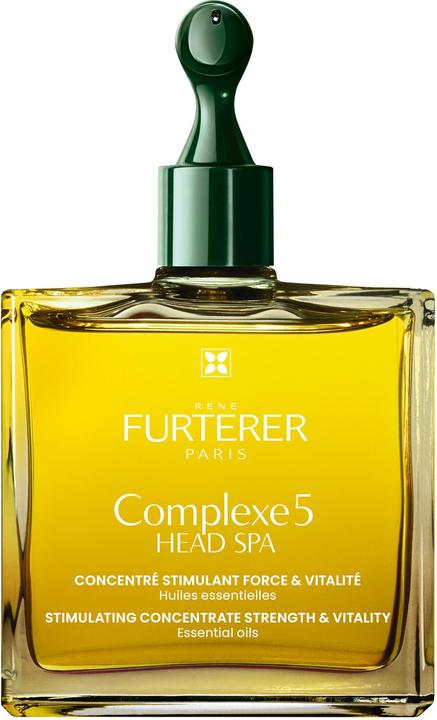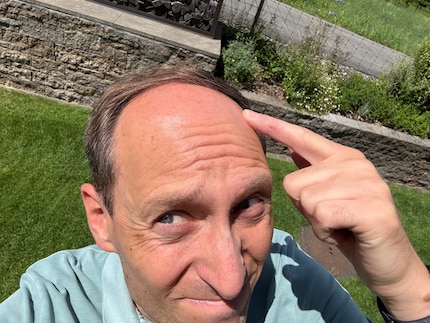

I arrived with a serum and left with tablets
My hairline’s receding. It’s a family heirloom I could do without. Can I delay the inevitable with an anti-hair loss treatment? I want to get to the bottom of things and am given comfort pills-
When I got my hands on a sample of the hair treatment Triphasic Progressive by René Furterer, I was immediately intrigued. The packaging promises all sorts of things:
- +10,023 hairs after 3 months
- Efficacy in 1 month
- Professional formula – 3 patents
Sounds like something worth trying. But if I’m going to test it, I want to do it properly. When it comes to hair, my expertise is limited to losing it and regularly going to the hairdresser’s, who does a really good job of managing what’s left. And I feel like my hairdresser might be worried about losing out on future business, as he never fails to mention that good friend in Turkey who offers affordable hair transplants.
However, the time, pain and costs put me off. A tonic that I pour into my hair once or twice a week is much cheaper and less work, even if I also have to wash my hair with a special shampoo and then massage a stimulating serum into my scalp.


Rene Furterer Triphasic shampoo for hair loss
200 ml, Liquid shampoo

My plan is to do a before-and-after comparison. After all, I don’t trust the claim of exactly 10,023 more hairs that’s printed on the René Furterer product.
That’s why I visit the practice of Dr Ralph Trüeb in Wallisellen (page in German). He’s one of Switzerland’s most renowned hair experts, a professor of dermatology and author of a series of specialist books. Dr Trüeb doesn’t accept any new patients and doesn’t make exceptions, even for a journalist conducting research. Instead, Dr Cristina Garcia Bielsa leads me into the treatment room. On her computer screen, we look at the photos of my visibly receding hairline, taken shortly before by a healthcare professional.
Finding the reason for this hair loss isn’t exactly material for a new episode of Dr House. It’s a straightforward diagnosis: I have hereditary hair loss. The medical term is androgenetic alopecia. My age (47), the hair history of the men in my family, and the photos of my head lead to a clear diagnosis. As Dr Garcia explains, my genes mean my hair roots become weaker over the course of a lifetime. First, they produce thinner new hair, and then eventually they die and don’t produce any new hair at all. The result is a receding hairline – and a growing forehead.
And once the hair’s gone, it doesn’t come back. Dead hair roots can’t be revived. The only way to have hair grow back on bald areas would be through hair transplant surgery. This involves removing individual hair roots from the back of the head with special needles and implanting them at the front. Sounds painful.

Hair roots take breaks too
Nevertheless, I’m not a completely hopeless case. The doctor says what I can do is strengthen the hair roots that are still doing their job properly. «With this?» I ask, placing the green Triphasic Progressive box on the table. Ms Garcia studies the list of ingredients. She finds some good ones, such as various vitamins, plant extracts and oils. But these won’t bring new hair roots back to life. What the product can do, however, is stimulate the scalp.
And what about the promised 10,023 more hairs? I dig a bit deeper and find more information online. The claim is based on a study with 60 people, which determined the average increase in the number of hairs in the growth phase. It’s important to note that hair roots work in shifts, following a cycle of growth, transition and rest phase. The growth phase lasts the longest, from two to six years, and 80–90% of your hair is in this phase. 10–15% is in the resting phase, which lasts two to four months. Nothing grows during this phase, the blood supply to the root is stopped and the hair falls out. You lose around 100 hairs per day in this phase. Once this cycle’s completed, the hair follicle has regenerated and the cycle starts all over again.
I’m given tablets
So does that number René Furterer states include the hair that would grow back anyway? What was the basis for this calculation? What’s for sure, and my doctor confirms this, is that treatments such as the Triphasic Progressive serum can definitely help. However, there’s virtually no effect for people with hereditary hair loss. So if, for example, René Furterer’s study included many women with hormone-related hair loss, the results could actually have been that good. Not so if only men with my condition had been in the test group.
Long story short, the Triphasic Progressive treatment won’t significantly change my life. That’s why I’ve decided to pass it on to someone else. Ms Garcia hands me a box that’s been designed with noticeably less marketing budget – Minoxidil tablets. They’re supposed to cause the blood vessels to dilate, allowing the follicles to be better supplied with nutrients, which will then grow back thicker and fuller hair. However, this only works as long as I take the tablets. As soon as I stop, my balding genes will take over again.

Journalist since 1997. Stopovers in Franconia (or the Franken region), Lake Constance, Obwalden, Nidwalden and Zurich. Father since 2014. Expert in editorial organisation and motivation. Focus on sustainability, home office tools, beautiful things for the home, creative toys and sports equipment.
Interesting facts about products, behind-the-scenes looks at manufacturers and deep-dives on interesting people.
Show all

